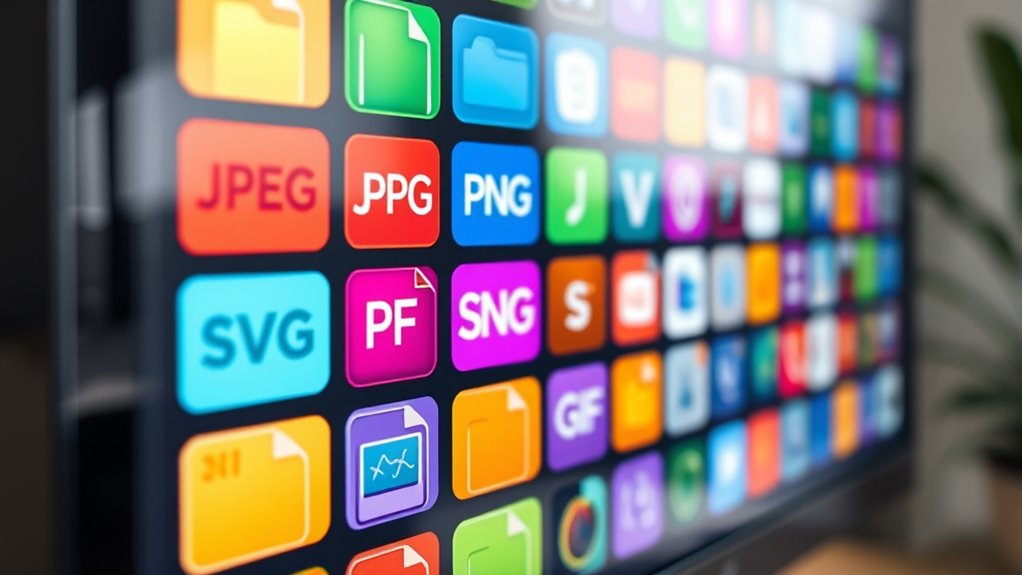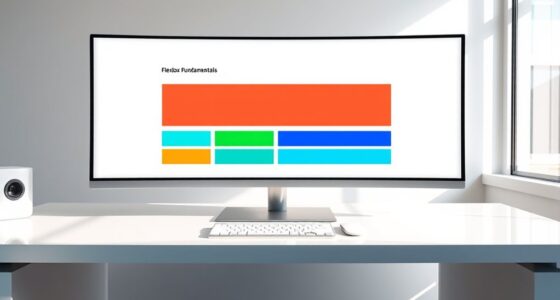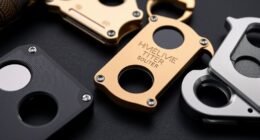To understand web image file formats, you need to know their strengths and best uses. JPEG works well for photos with many colors, while PNG is perfect for images needing transparency and sharp lines. GIF is common for simple animations, but modern formats like WebP offer high-quality visuals with smaller sizes. Choosing the right format can improve your site’s performance and appearance—exploring these options will help you make smarter choices.
Key Takeaways
- JPEG is ideal for photographs, offering good compression with minimal quality loss, but lacks transparency support.
- PNG provides lossless compression, supports transparency with alpha channels, and is best for images requiring sharp edges.
- GIF supports simple animations and limited colors, with transparency via a single transparent color, suitable for basic animations.
- Modern formats like WebP balance compression and quality, supporting both static and animated images for faster web loading.
- Choosing the right format depends on image content, transparency needs, animation requirements, and browser compatibility.
Common Image Formats and Their Characteristics
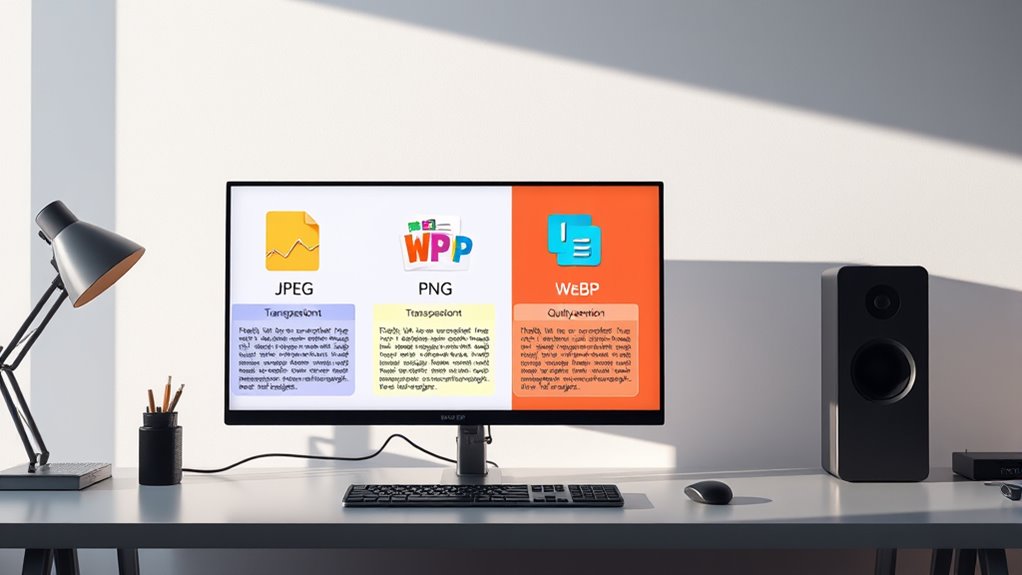
Understanding common image formats is essential because each one is designed for specific uses and offers different benefits. JPEG is perfect for photographs with many colors, providing good compression without sacrificing too much quality. It’s widely supported and ideal for web photos, but it’s a lossy format, meaning some detail is lost during compression. PNG is best for images requiring transparency or sharp lines, like logos or icons. It uses lossless compression, so images stay crisp but often have larger file sizes. GIF is mainly used for simple animations and graphics with limited colors. It supports transparency but only in a binary way. Knowing these characteristics helps you choose the right format for your needs, ensuring your images look good while keeping file sizes manageable. Additionally, understanding angel number meanings can help you recognize the significance of visual cues and symbols in digital content. Recognizing content compatibility across various platforms is also crucial for delivering your images effectively. Being aware of image optimization techniques can further improve your website’s performance by reducing load times and enhancing user experience.
Comparing JPEG, PNG, and GIF
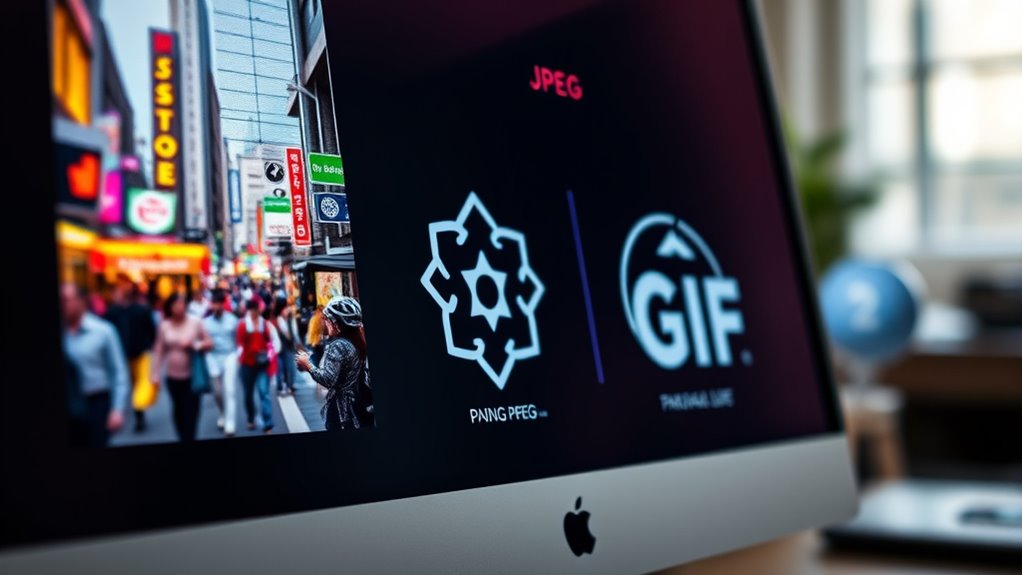
You’ll notice that JPEG, PNG, and GIF each use different compression methods, affecting image quality and file size. They also vary in supporting transparency, which influences how you can overlay images on backgrounds. Additionally, GIFs can animate, while JPEGs and PNGs are static, making each format suited for different purposes. Understanding the specific compression techniques used by each format is essential for optimizing images for web use. Moreover, the color support differs among these formats, impacting how vibrant or detailed an image appears. For example, PNGs often support a wider color palette, which enables more detailed and colorful images. The choice of format can also influence loading times and overall website performance, especially on mobile devices. Recognizing the intended use of an image can help you select the most appropriate file format for your needs.
Compression Techniques Differences
Have you ever wondered how different image formats manage file size and quality? JPEG uses lossy compression, which reduces file size by discarding some image data, often leading to slight quality loss. This makes JPEG ideal for photographs with complex colors and gradients. PNG employs lossless compression, preserving every detail without quality degradation, but usually results in larger files. It compresses images by finding patterns and redundancies in pixel data. GIF uses a form of lossless compression suited for simple images with limited colors, like animations or icons. Its compression relies on color palette reduction and pattern matching. Each format’s compression technique affects how well it balances quality and file size, influencing your choice based on your needs—whether for web speed, image quality, or transparency features. Understanding the specific compression techniques helps optimize images for various applications.
Transparency Support Variations
Ever wondered how different image formats handle transparency? JPEG doesn’t support transparency at all, which means backgrounds behind the image will always be solid colors. PNG, on the other hand, offers full alpha channel transparency, allowing you to create images with smooth, semi-transparent edges and complex transparency effects. PNG is widely used in digital design due to its ability to handle detailed transparency seamlessly. PNG’s support for alpha transparency makes it ideal for overlaying images on various backgrounds without harsh edges. Additionally, PNG’s compatibility with Honda tuning graphics demonstrates its versatility in high-quality visual presentations. PNG also supports various color depths, enabling a broad range of visual fidelity for different projects. GIF supports transparency too, but it’s limited to a single transparent color, so edges can appear jagged or blocky. If you need detailed transparency and smooth blends, PNG is your best choice. For simple transparency needs, GIF works but with noticeable limitations. JPEG is unsuitable if transparency is essential. Understanding these differences helps you pick the right format based on your transparency requirements and the visual quality you want to achieve. Advances in machine learning algorithms continue to improve image processing techniques, making it easier to optimize transparency effects in various formats.
Animation Capabilities
While transparency varies across formats, their ability to support animation differs particularly. GIFs excel at simple animations, allowing you to create looping images with multiple frames. They’re widely used for short clips, memes, and user interface elements thanks to their straightforward animation capabilities. They are also popular for short, repetitive content, due to their limited color palette and simplicity. PNG files, however, do not support animation natively, so they can’t be used for moving images. JPEGs are static; they lack any animation support altogether. If you need animated images, GIFs are your best choice, especially for brief, repetitive content. Keep in mind that GIFs have limited color palettes, which can affect image quality. PNGs and JPEGs are better for high-quality static images, but if animation matters, GIFs are the go-to format. Additionally, animation support varies significantly among formats, influencing their suitability for dynamic visuals.
When to Use WebP and Other Modern Formats
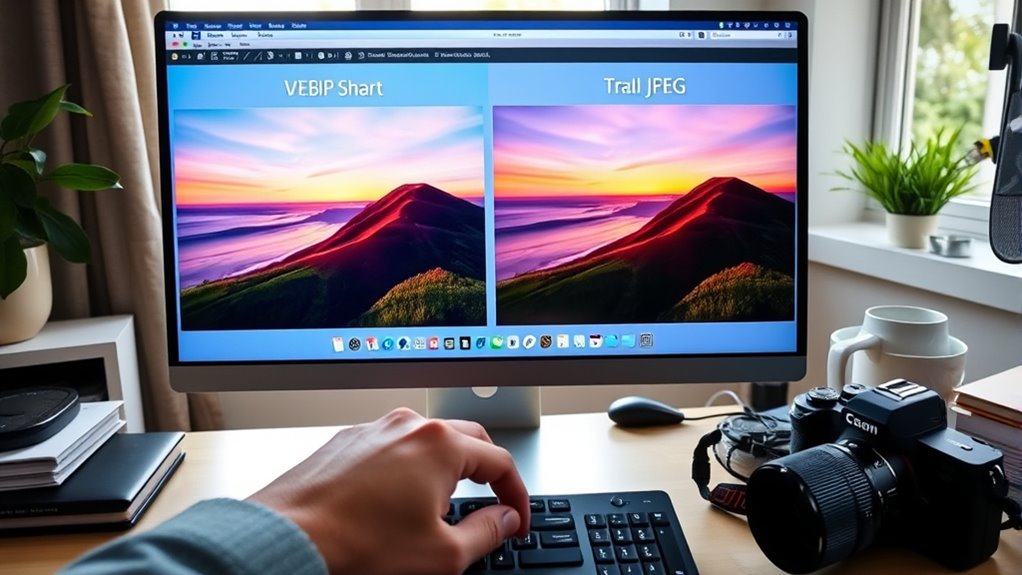
You should consider using WebP when you need smaller file sizes without sacrificing quality, especially for web pages. However, it’s important to check if your audience’s browsers support it fully, as compatibility can vary. Balancing efficiency benefits with compatibility needs helps you choose the right format for your images.
WebP Efficiency Benefits
WebP offers significant efficiency benefits when you need high-quality images with smaller file sizes, making it ideal for web use. Its advanced compression reduces load times and saves bandwidth without sacrificing visual quality. You should consider WebP for websites aiming for faster performance, improved user experience, and better SEO. Its versatility covers both lossy and lossless compression, giving you flexibility depending on your needs. Using WebP can also help you:
- Minimize storage costs by reducing image sizes
- Enhance page speed, lowering bounce rates
- Improve mobile performance on slower networks
- Support rich visuals while maintaining quick load times
Choosing WebP assures your site remains visually appealing while optimizing efficiency, especially when managing large image libraries or aiming for faster browsing experiences.
Compatibility Considerations
Choosing the right image format depends on your website’s compatibility needs and target audience. WebP offers excellent compression and quality but isn’t supported everywhere. If your visitors use older browsers or specific platforms, sticking with JPEG or PNG might be safer. Consider your audience’s devices and browsers before switching.
| Format | Compatibility | Best Use Case |
|---|---|---|
| WebP | Modern browsers only | Fast-loading images, small size |
| JPEG | Almost all browsers | Photos with complex colors |
| PNG | Most browsers | Transparent graphics, logos |
| GIF | Widely supported | Simple animations |
This table helps you weigh options, ensuring your images perform well without sacrificing accessibility.
Understanding Compression and Quality Trade-offs
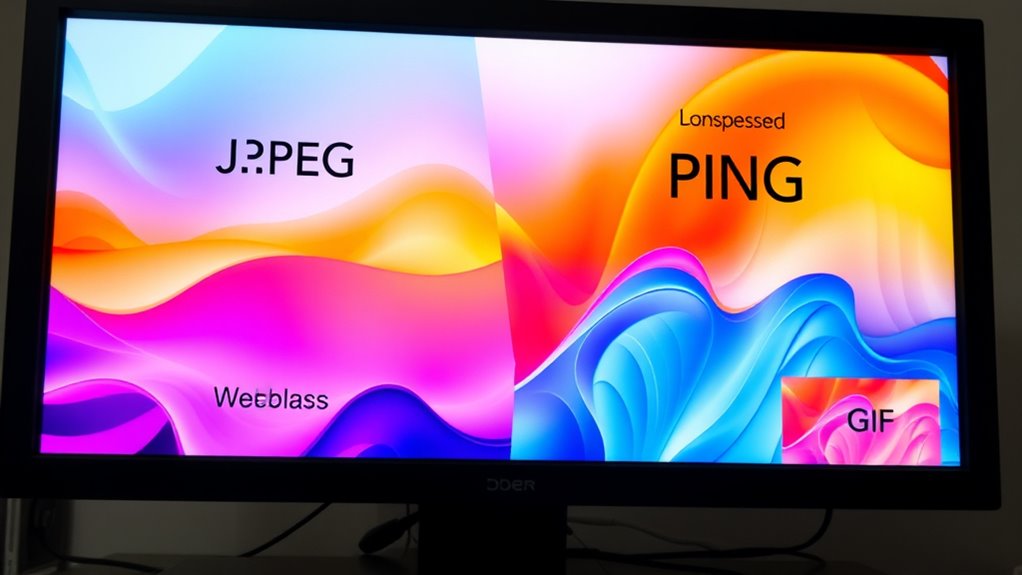
Understanding how compression affects image quality is essential when selecting the right file format for your web images. Compression reduces file size, improving load times, but can also degrade visual quality. Striking the right balance involves considering how much detail you’re willing to lose for faster performance.
Balancing compression and quality is key to optimizing web images effectively.
Key points to remember include:
- Higher compression lowers file size but can introduce artifacts or blurriness.
- Lossless compression preserves quality but results in larger files.
- Lossy compression sacrifices some detail for significant size reduction.
- Adjusting compression settings allows you to find an [best] balance based on your needs.
Optimizing Images for Different Devices and Browsers
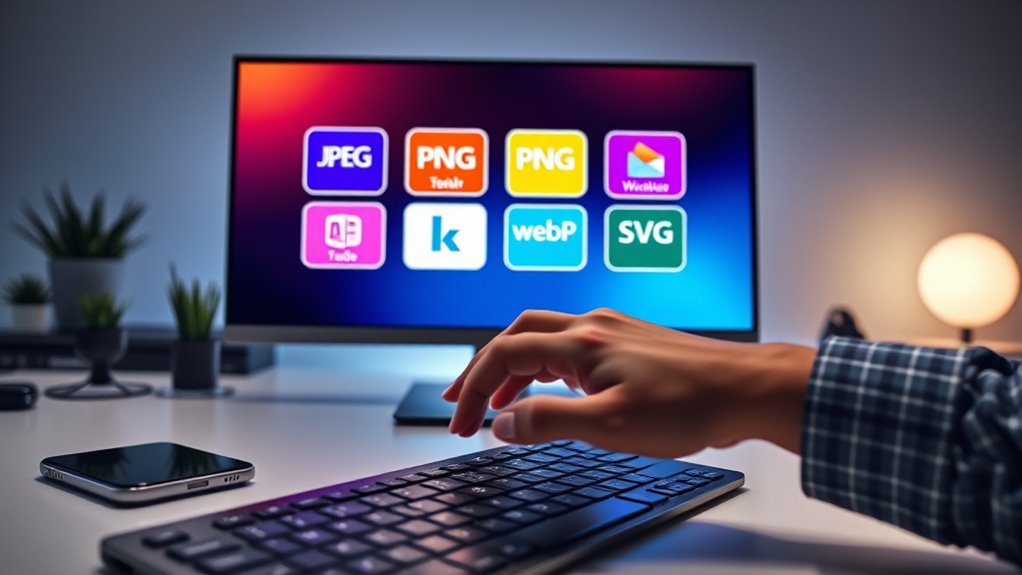
Optimizing images for different devices and browsers is essential to guarantee fast load times and a seamless user experience. Start by using responsive images that adapt to various screen sizes, such as employing the HTML srcset attribute. Compress images appropriately to reduce file size without sacrificing quality, ensuring they load quickly on mobile devices and slow connections. Consider browser compatibility; some browsers favor specific formats like WebP or AVIF, so provide fallback options for older browsers. Use scalable vector graphics (SVG) for logos and icons to maintain crispness across all screens. Additionally, leverage lazy loading techniques to delay loading images outside the viewport. By tailoring images to device specifications and browser capabilities, you improve performance and enhance overall user satisfaction.
Tips for Selecting the Best Format for Your Website
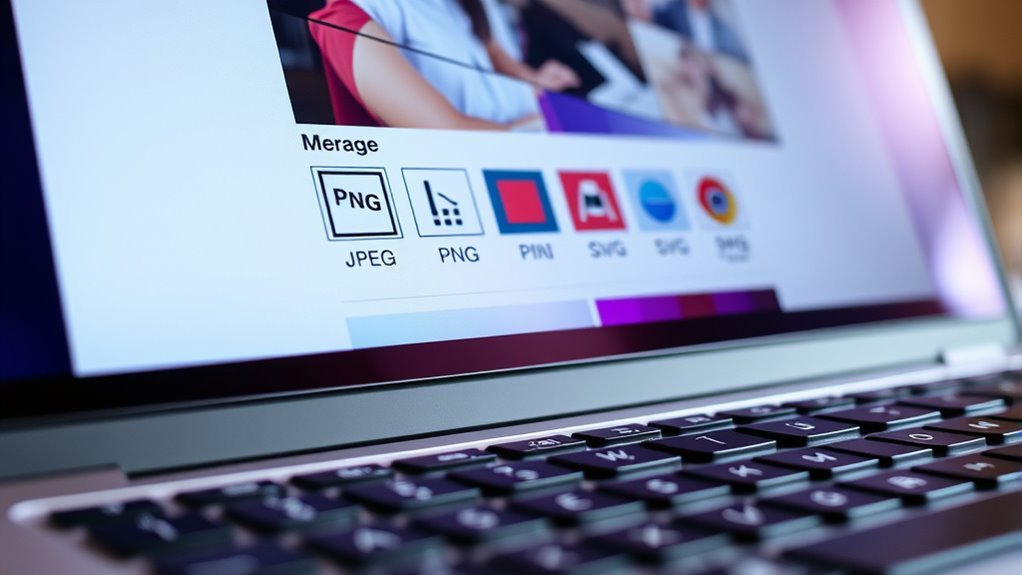
Selecting the right image format for your website can considerably impact load times and user experience. To choose wisely, consider your image’s purpose and quality needs. For photos with rich colors and details, JPEG offers good compression without sacrificing much quality. For graphics with transparency or sharp edges, PNG is ideal. WebP provides a balance, supporting transparency and smaller file sizes. GIFs work well for simple animations. Keep these tips in mind:
- Use JPEG for photographs to ensure fast loading.
- Opt for PNG when transparency or sharp contrast is essential.
- Choose WebP for versatile, compressed images.
- Avoid overly large images; resize before saving.
Making informed choices enhances site speed, visual appeal, and user satisfaction.
Frequently Asked Questions
How Do I Convert Images Between Different Web Formats?
You can convert images between web formats using online tools or software like Photoshop, GIMP, or specialized converters. Simply upload your image, choose the desired format (like JPEG, PNG, or WebP), and start the conversion. Most tools allow you to adjust quality settings and resize images as needed. Once done, save the new file to your device. This process is quick and guarantees your images are optimized for the web.
Are There Accessibility Considerations for Image Formats?
When considering accessibility for image formats, you should prioritize clear, high-contrast visuals and descriptive alt text. Choose formats like PNG or SVG for sharp, scalable images that remain clear on all devices. Avoid overly complex or heavily compressed formats like JPEG when accessibility is a concern, as they can reduce clarity. Ensuring your images are properly labeled and optimized helps all users, including those with visual impairments, access your content effectively.
What Security Risks Are Associated With Specific Image Formats?
Think of image formats like secret agents—each has unique strengths and vulnerabilities. For instance, JPEG files can hide malicious code through steganography, risking hidden malware. PNGs are generally safer but can be exploited with specially crafted files. You need to be cautious when opening images from unknown sources, keep software updated, and use security tools. This way, you minimize risks and protect your system from image-based attacks.
How Do Image Formats Impact Website Load Speed?
You’ll notice that image formats directly impact your website’s load speed. For example, compressed formats like JPEG or WebP reduce file size, allowing pages to load faster. Conversely, uncompressed or larger formats like BMP and TIFF slow down your site. Choosing the right format, optimizing images, and balancing quality with size help improve user experience and decrease bounce rates, keeping your website swift and efficient.
Can Certain Formats Support Animations or Interactive Elements?
You wonder if certain image formats can support animations or interactive elements. Formats like GIFs and APNGs bring animations to life, allowing you to add movement and engagement. SVGs, on the other hand, support interactivity with clickable or animated graphics that respond to user actions. These formats let you create dynamic, eye-catching content that enhances user experience, making your website more lively and engaging.
Conclusion
Think of choosing an image format like picking the right key for a door. Each has its rhythm—JPEG’s smooth dance, PNG’s detailed steps, GIF’s playful hop, and WebP’s sleek glide. By understanding their moves, you release the perfect fit for your website’s needs. When you match the key to the door, your images shine, load fast, and invite visitors in—making your site a welcoming, harmonious space.
